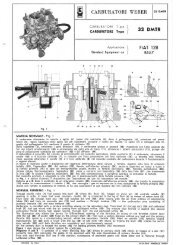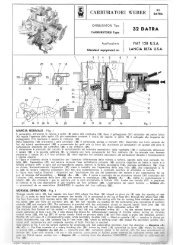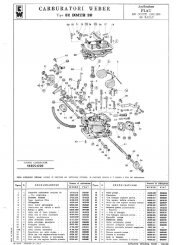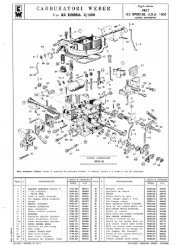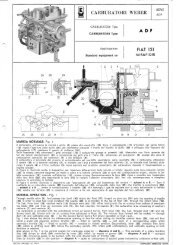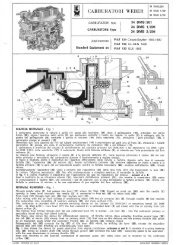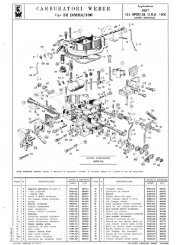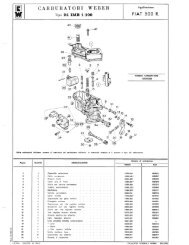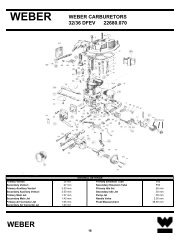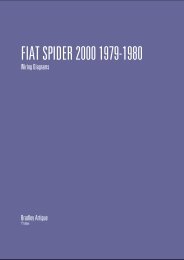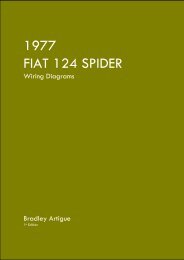Engine Maintenance and Modification Bradley Artigue
FIAT 124 Spider Engine Maintenance + Modification - Artigue.com
FIAT 124 Spider Engine Maintenance + Modification - Artigue.com
- No tags were found...
Create successful ePaper yourself
Turn your PDF publications into a flip-book with our unique Google optimized e-Paper software.
FIAT 124 Spider<br />
<strong>Engine</strong> <strong>Maintenance</strong> + <strong>Modification</strong><br />
8. Exhaust System<br />
The exhaust system conveys spent gasses from the cylinder head to the exterior of the<br />
car. Exhausts perform a number of valuable functions <strong>and</strong> exhaust design is crucial to<br />
good engine performance. Emissions, noise, <strong>and</strong> backpressure are key concerns in<br />
exhaust design. Emissions must be safely conveyed away from the passenger<br />
compartment; in the case of the FIAT Spider they are reduced by a catalyst <strong>and</strong> expelled<br />
behind the vehicle. Noise produced by an engine must be muffled in order for the<br />
vehicle to function in society; therefore a muffler is installed at the rear of the vehicle to<br />
reduce exhaust noise. Spiders also have a center resonator, an additional muffling<br />
device located above the rear axle. Backpressure exists if gasses escaping the engine<br />
meet resistance <strong>and</strong>, taking into account the safety <strong>and</strong> environmental features noted<br />
above, is the focus of good exhaust system design.<br />
A poorly-designed exhaust manifold may create pressures that inhibit the engine’s ability<br />
to breathe. Many vehicles have intricate exhaust systems, designed specifically to<br />
equalize the length of each cylinder’s exhaust pipe. FIAT Spiders used two types,<br />
known as 4-2-1 <strong>and</strong> 4-1; the former is considered to be a superior design. Aftermarket<br />
headers are also produced, each touting improvements to the original designs (with<br />
dubious pedigree; refer to the section titled “improvements” later in this book.)<br />
There are two types of the 4-2-1 design. The first was fitted to 1756cc Spiders<br />
manufactured in 1974. There are four pipes running from the exhaust side of the engine,<br />
tapering down to where a flanged two-pipe fitting mates <strong>and</strong> extends under the car.<br />
Here a single pipe leads through a catalytic converter (or not, depending on year),<br />
through mufflers <strong>and</strong> out of the car. The second type of 4-2-1 was installed on the fuel<br />
injected Spiders. It is similar in design except the four primary pipes bend into two <strong>and</strong><br />
into a collection “box” where the oxygen sensor is installed. The 4-2-1 was designed for<br />
Spider engines in the 100+ HP range <strong>and</strong> is at least as good (arguably better) as most<br />
“performance” aftermarket systems.<br />
The 4-1 design was installed on most Spiders <strong>and</strong> in every engine displacement. Four<br />
short pipes extend from the exhaust manifold into a single pipe that runs under the car<br />
to the catalyst <strong>and</strong> onwards. The design is simple <strong>and</strong> the exhausts are very well built.<br />
They suffer only from the rather abrupt turns from the exhaust ports to the down pipe<br />
<strong>and</strong>, unless the engine is going to produce more power than stock, may not be worth<br />
replacing.<br />
8.1 Exhaust System Identification<br />
Look in your engine compartment at the exhaust side of the engine. There may be a<br />
metal heat shield on top of the exhaust - it will have three 13mm nuts securing it down.<br />
The exhaust system parts have the part numbers stamped into them. It is very unlikely<br />
that a Spider will have the original parts from the down pipe back.<br />
64



